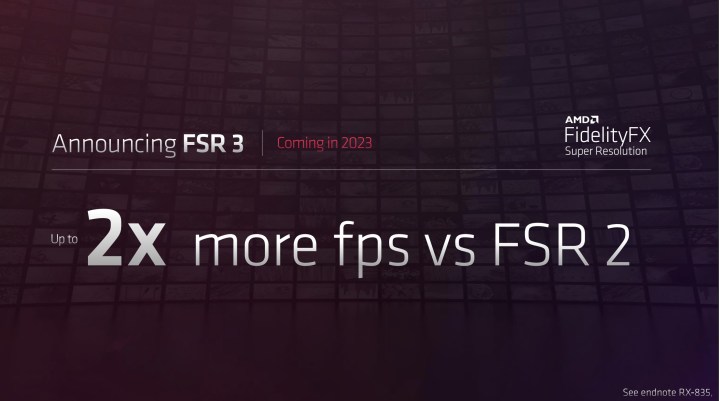Despite just launching FidelityFX Super Resolution (FSR) 2.0 in June, AMD just announced FSR 3.0 at its RDNA 3 launch event — along with a new piece of tech AMD is calling Fluid Motion Frames. We don’t have a ton of details yet, but FSR 3.0 looks to go toe-to-toe with Nvidia’s Deep Learning Super Sampling (DLSS) by generating unique frames all on its own.
According to AMD, FSR 3.0 will provide up to twice the frame rate as FSR 2.0, which seems to come exclusively from the Fluid Motion Frames technology. AMD hasn’t shared any details on how this tech works, but the company confirmed that it is using frame generation similar to Nvidia’s recently released DLSS 3.

As we break down in our RTX 4090 review, DLSS 3 has two components — the normal super-resolution that you see in tools like FSR and DLSS, and frame generation. DLSS 3 can generate a new frame every other frame without a single pixel being rendered. Theoretically, that means the potential to double your frame rate, even beyond what you get with traditional upscaling.
We don’t have concrete details on FSR 3.0 from AMD yet, so it’s impossible to say if Team Red is taking the same approach. The performance claims combined with the inclusion of frame generation suggest that FSR 3.0 will work in a similar way, however.
The missing piece is if FSR 3.0 will use AI. DLSS 3 hinges on AI accelerators inside the RTX 4090, which allow the GPU to generate new frames without loads of artifacts. The RX 7900 XTX and RX 7900 XT include AI accelerators now, which suggests that FSR 3.0 may take advantage of them. AMD is still being tight-lipped about that particular detail, though.
When asked about FSR 3.0 and its potential use of AI by Jarred Walton of Tom’s Hardware, AMD executives simply responded: “The current versions of FSR do not use machine learning.”
We have more questions than answers about FSR 3.0 at the moment, but it’s clear that AMD intends to take the fight back to Nvidia. DLSS 3 marked a major shift where Nvidia re-established an underhand over AMD in upscaling tech, but FSR 3.0 seems positioned to balance those scales. It’s hard to say much concrete right now, though.
AMD says FSR 3.0 will arrive in 2023, but it didn’t provide a release date beyond that point. FSR 2.0 is still relatively new, and despite seeing rapid adoption, the tech still hasn’t made its way into every game. The recently released Call of Duty Modern Warfare 2, for example, uses FSR 1.0 instead of the updated version.
In the meantime, AMD announced that FSR 2.2 is available, releasing in Forza Horizon 5 soon. The company didn’t provide an exact date. FSR 2.2 is said to bring improvements in temporal artifacts, but it looks like an image quality update for FSR 2.0 than a wholly new version.




